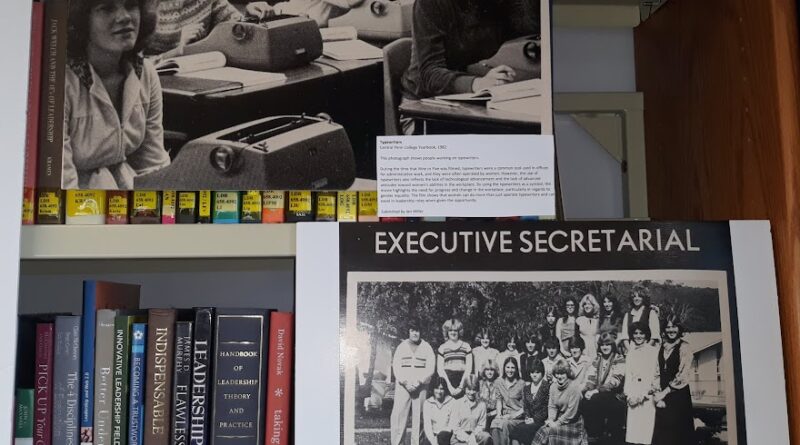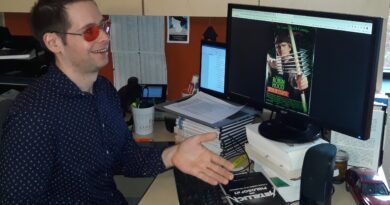Library exhibit of class research findings looked back at CPC
The late-spring display was pure Central Penn hands-on learning

Story and photos of exhibit items
By Michael Lear-Olimpi
Knightly News Editor
michaellear-olimpi@centralpenn.edu
Were you workin’ 9 to 5 and needed a break between winter and spring terms this year? Did you meander through the exhibit in the Central Penn Library leadership reading room?
If you did, then no doubt you found the exhibit students in Professor Amanda Stuckey’s winter-term selected-topics-in-film class created showing workplace culture over the last 40 years at Central Penn an informative experience.
They produced the exhibit — called Central Penn & the Cinema: Four Decades of Workplace Culture and Campus Life on the Screen and in the Archives — from materials found mainly in the library’s holdings. Exhibit posters showed scenes of work and learning culture at Central Penn from those years and compared that to scenes of workplace culture in the movies students had watched.

The research question students explored focused on how career-focused learning workplaces changed over time, or didn’t.
“We usually think about movies as an escape from the workplace, but the workplace has been a surprisingly frequent topic in many movies for many decades,” Stuckey, assistant professor of humanities, explained in an email. “We watched five main movies: ‘9 to 5’(1980), ‘Groundhog Day’(1993), ‘Office Space’(1999), ‘Love & Basketball’(2000) and ‘The Social Network’(2010). If we had time, we were going to watch ‘Hidden Figures’(2016) and ‘Emily the Criminal’(2022).”
Central Penn hands-on learning

Stuckey’s approach to the class – Interdisciplinary Studies 205, with the topic of Central Penn and the cinema – was for students to conduct hands-on research on how Central Penn classes and daily business at the college looked through 40 years, the school’s tenure in Summerdale.
She said first-person research is always part of her classes.
Stuckey wanted students to watch the movies and think not only about what the directors and actors and sets portrayed but to observe and interpret what they saw with “authentic research experiences.”
“Diving into archives and putting together an exhibit raises a range of research problems and questions,” she explained. “What do you do with artifacts that may not make a lot of sense to you right away? How can you make direct connections between what you see on the screen? What do you do when you make a problematic connection? For example, the majority of the movies we watched had a largely white cast. We found the same to be true of Central Penn’s student body during the 1970s, 1980s, 1990s and 2000s.”
Some of the movies deal with weighty social issues and are based on true events, such as workplace gender equality, workplace racial and gender diversification, and the general evolution of U.S. workplaces – from typical 1970s corporate offices to the offices of Facebook.
The movie “9 to 5,” for example, wasn’t just a movie and a Top 40 theme-song radio hit. According to the Public Broadcasting Service’s Independent Lens website, 9to5 was a movement a group of Boston secretaries created in the 1970s to make equal pay and advancement opportunities a reality for women. They also wanted to call attention to and stop sexual harassment against women, who held almost all secretary – “administrative assistant” now – jobs.

“Hidden Figures” heralds the critically important contribution of Black women mathematicians at NASA in the success of the 1960s Space Race between the United States and the Soviet Union that resulted in the Apollo space program capping the decade by putting the first people on the moon, U.S. astronauts Neil Armstrong and Edwin Aldrin.
Primary sources included Central Penn yearbooks, student newspapers, alumni publications and course catalogs. Stuckey explained that immersion in the material, along with class discussion and study, provided context for students to interpret and to understand what they were learning about Central Penn campus life through primary sources, and to compare that to what they saw in the movies they watched.
The class also visited the campus museum, which is chock-full of artifacts of Central Penn’s history as a business school, such as typewriters and adding machines. Photographs and other material are also on display.

Some best outcomes for students?

“Doing this exhibit really opened my eyes to what CPC was like way back before technology became so advanced,” Sierra Phillips, a senior business major, said. “It made me think and dive deep into the historical realm of CPC.”
Business administration major Andrew Hunter gained insights from and had a good time with the project.
“I enjoyed it,” Hunter said. “It was cool to see the materials we found in the library. I liked learning about how things were here in those times. I liked the movies, too.”
Stucky said the project was a collaboration. She discussed the idea with then-Central Penn Library Director Diane Porterfield, who mentioned the movie “9 to 5.”
“We all worked together,” Stuckey said. “The final goal was for students to review yearbooks, student newspapers, course catalogs, student handbooks, and alumni publications, (and) select one object to connect to each of the five movies.”
The students then wrote labels identifying the exhibit items – “artifacts” – explaining the context of the item. Each student explained on labels at least three exhibit items. The labels also provided context on the connection to office scenes in the movies they watched.
They kept track of the project with a chart identifying where in the library objects for the exhibit were found, along with the publication year of each information source and why students selected each item for the project.
Stuckey said students spent three class sessions collecting data. Students used artificial intelligence programs in their work, too.

“We used ChatGPT to do summaries of each movie to include with the groupings of items in each decade, and revised the summaries to bring out the details most relevant to the items we chose,” she said.
She printed photos onto foam boards for the display.
Best part for Stuckey?
“Being a fly on the wall for the reactions, questions, conversations, and even gasps from students as we sifted through the primary sources,” Stuckey said. “There were some recurring themes that were illuminated: a work life balance, multiple forms of racial and gender inequity, and peoples’ relationship with technology.”
Surprises sprang up, too.
“Sometimes we would be surprised by how much things have changed, especially in some of the things that were considered ‘normal’ in the yearbooks related to depictions of female students,” Stuckey said. “But more surprising than that were the things that seemed to stay the same: We found, for example, an article from the 1990s about the need for a sports complex on campus.”
The exhibit provided not only hands-on learning but a way to touch the past and to connect it to the now and, perhaps, to the future.
Comment or question? Contact KnightlyEditors@CentralPenn.Edu.



